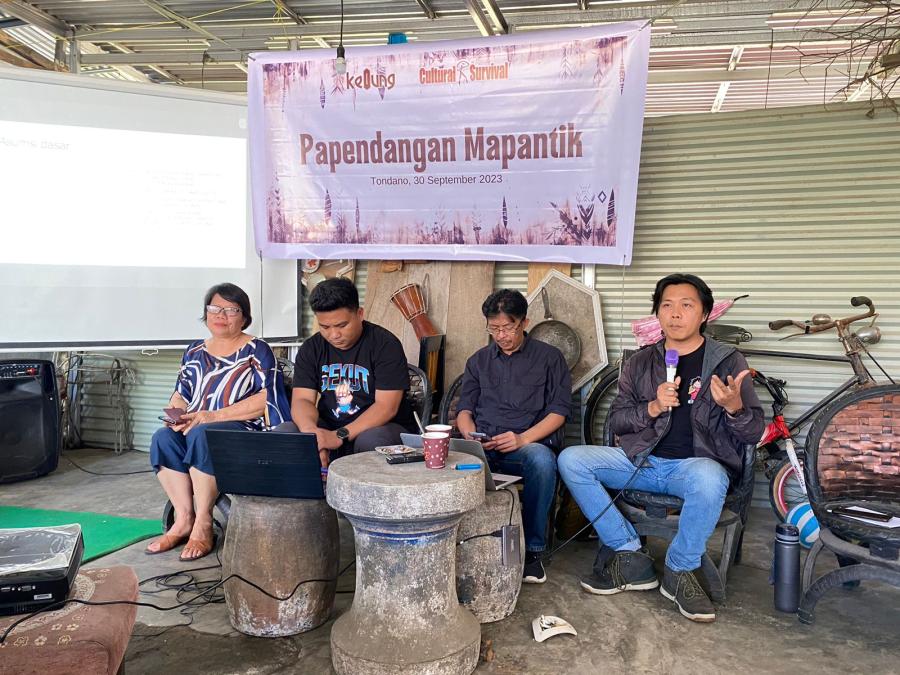The Indonesian island of Sulawesi, or Celebes, was once famous as the homeland of Buginese traders and pirates. Until recently, however, little was known in the West of the hundreds of thousands of Toraja people who lived in the mountainous interior of the island.
In the early 1970s, the West suddenly discovered the Toraja. Within a decade, Toraja sculpture was exhibited in major North American museums (1981), and tour groups led by well known Anthropologists and Social Scientists visited the regency described by a Museum of Natural History brochure as "the land of the heavenly kings of Tana Toraja." All this was the outcome of a shift in Indonesian government policy in the late 1960s, when the government embarked upon a vigorous promotion of tourism as a means of generating foreign exchange.
In 1971, about fifty European visitors attended rituals in the northwestern corner of Tana Toraja (known as Tator in acronymical Indonesian). In 1972, more than 400 tourists visited the area, where many witnessed the funeral ceremony for the Puang of Sangalla, believed to have been the highest-ranking nobleman in the land. The Puang's death rite became the first international media event to emanate from these highlands; recorded by a British film crew (financed by Ringo Starr), it was televised in several European countries. In the same year, the first of a spate of small publications in English and Indonesian appeared, naming, describing, and interpreting Toraja ritual and culture for the outsider. In 1976, 12,000 tourists may have visited the regency. The number of tourists has grown dramatically since then, as witnessed by the growth of hotels, Chinese restaurants, and souvenir shops in the two major towns, and by the opening of an airport in the regency last year.
Why tourism in Tana Toraja? Some of the answers are obvious. For one, Jakarta's own campaign has been complemented by the promotion of European tourist agencies, particularly in France and Germany, which sponsor package group tours. Secondly, the area is blessed with magnificent, lush scenery and a cool mountain climate. With cascading rice terraces, immensely tall bamboo stands, and misty mornings at altitudes between 3000 and 6000 feet, Tator is a sensory delight and a refuge from the tropical lowlands. Thirdly, perhaps most intriguingly, Toraja has been billed as a more remote, unspoiled alternative to Bali (now old hat to seasoned tourists), and, more fundamentally, as an alternative to the mundane, secular world of the West.
The chance to be in close contact with some version of the Other, the Exotic, the Primitive. Most tourists from most countries tend to regard the Toraja as a ritual being, specifically as a funereal being. In part this is coincidence, for Toraja death rituals traditionally occur in June, July, and August, after the harvest, nicely corresponding with the Western vacation calendar; and, for a variety of historically and cultural reasons, the Toraja strongly emphasize death ceremonies. The death ceremonies involve the sacrifice of large numbers of water buffalo and pig, the very visceral butchering of these animals (from which tourists often recoil), and the distribution of the raw meat. The ceremonies also involve a powerful sense of community participating in a rite of passage in which death is more visible and unmediated than in the West (as in the slaughter of beasts). Mortuary rituals in Tana Toraja have always been deeply tied to notions of social prestige. The deceased's status was vividly expressed through the number and quality of animals sacrificed, the number and quality (lineage and wealth) of guests attending, and the complicated ways in which meat was divided. Before Indonesian independence was achieved in 1949, investment in ritual performances reflected a social hierarchy (roughly based on nobles, commoners, and slaves) that had not changed drastically even throughout the Dutch colonial period (1907-42). Independence brought the status hierarchy into flux. Former slaves, for example, became wealthy through work in Kalimantan's growing timber industry. These migrants, upon their return, invested cash in expensive and prestigious rituals for their low-status families. By the 1970s, the ritual challenge to old hierarchies had led to some reevaluation of the ritual system, and members of the old elite began to call for reductions in the scale of animal sacrifice. Often such pleas were made in the name of modernization: it was time, people said, for the Toraja to stop squandering their wealth and energy through ritual. During this period, however, migration from the hinterlands to Kalimantan's forests and to urban areas in Sulawesi continued to grow rapidly. As new wealth was tunneled to Toraja, ritual flourished rather than subsided. This, then, was the situation in which Toraja tourism was generated. Conveniently for tourist agencies, ritual was already growing, and it was fairly easy for tour groups to find a funeral any summer day. At the same time, tourism served to encourage the ritual revival, since to the Toraja the new guests - white and wealthy, if bewildered - seemed to affirm the importance of traditional ritual, the centrality of one's own family within the social universe. Yet as tourism contributed to the expansion of ritual, it simultaneously undermined its worth. Some Toraja had already begun to perceive ritual as an unproductive, anti-modern obsession (if only to preserve their own positions now challenged by the rituals of the nouveaux-riches). Tourism then, furthered the confusion about ritual's proper place, scale, and meaning. Some tourist proponents simply staged "authentic" ceremonies. One entrepreneur, for example, spent a good deal of time and money in 1978 on an elaborate house-opening ceremony to inaugurate her new hotel, located in her native village. Even the architecture was partly "authentic": the hotel stood on tall piles, beneath a swooping, arc-shaped roof. Guests were invited to sleep on the floor on woven mats. Although this woman was a staunch Dutch Reformed Protestant, she hired a traditional religious specialist to perform the ritual according to the "religion of the ancestors." She was proud of his impeccable, esoteric "high speech," for although the tourists understood not a word (nor could they distinguish it from "ordinary speech"), she felt that she owed this authenticity to her Western guests. Tourism and religion are intertwined. For decades Dutch missionaries struggled to win Toraja souls away from "animism." Not until the 1950s and 60s, however, when the Dutch had left, did large numbers of Toraja convert to both Protestant and Catholic churches, and today nearly half of the regency's 320,000 persons are Christian. Christianity is taught in the schools and associated with modernism and an effective identity in a state dominated by Islam. "Animism," on the other hand, is associated with old people and out-moded ways. A prominent, well-educated politician, who is also closely connected to the regency's tourist office, has been attempting to revitalize the "religion of the ancestors." The first step toward legitimizing that ancient belief system was its official recognition by Jakarta in 1969, when it was classed as a branch of "Hindu-Dharma," and named aluk to dolo, roughly "religion of the ancestors." The prospects for aluk to dolo to become a major religion in Tator are slim, but its promotion points to the paradoxes of the whole process of tourism in this area and elsewhere. For decades the Toraja have been told that their ancestral gods and practices are antiquated, foolish, even satanic. Now they must be persuaded that the old traditions are the path to lead them successfully into the modern world. Those traditions will lure tourists from afar, modern travelers bearing cameras and cash. The economic questions in the Toraja case still await analysis. As in similar situations everywhere, it seems evident that a few important families who own hotels and restaurants are the main beneficiaries of the new cash flow. From the ordinary Toraja's point of view, the economic gains made in a year's labor in Kalimantan may be leveled in a single afternoon of buffalo slaughter. Clearly, tourism cannot be held responsible for Toraja ritual sacrifice or prestige competition. But neither can the expansion of ritual be encouraged on the grounds that the resultant tourism will lead to economic growth throughout the society. A few of tourism's beneficiaries are Buginese tour operators, based in the southern city of Ujung Pandang. Their control of portions of the tourist trade is resented by some Toraja, while some Buginese resent the great attention now paid to their upland "pagan" or Christian neighbors. The Buginese, who are Muslims, express the view that tourism has unjustly ignored their own gentle landscape, colorful marriage ceremonies, and, in their eyes, more sophisticated culture. The recently completed airport in Tana Toraja could provide a means of totally bypassing Buginese areas, a fact that has not gone unnoticed. It remains to be seen whether tourism will realize its potential to aggravate long-standing rivalries between these two neighboring ethnic groups. Perhaps the most ambiguous consequence of tourism is its effect on the Torada's own perceptions of their culture and their identity. While tourism brings thousands of strangers to witness local rites, as if to affirm and enhance their significance, it simultaneously reduces the Toraja to colorful, exotic sources of spectacle. The availability of a tourist lens through which to view themselves has led the Toraja to a strangely distant perception of their own tradition: postcards, miniature houses, heirloom cloths, even rituals can now be reproduced, bought, and sold. Article copyright Cultural Survival, Inc.



